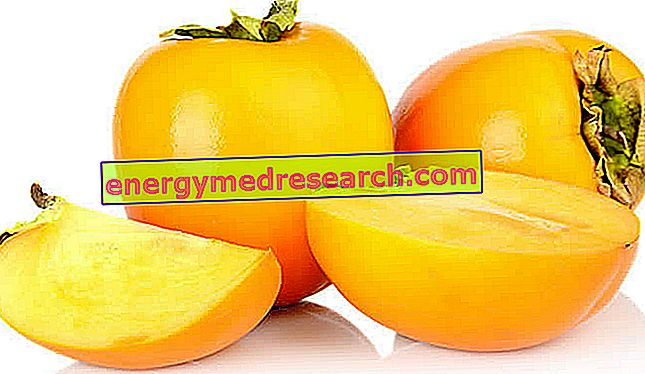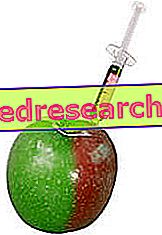Watch the video
X Watch the video on youtubeGeneralities and Features
Caco apple, khaki apple or cacomela are the nouns with which, in common parlance, we identify some varieties referring to the botanical species Diospyros kaki . The commercial interest is specifically aimed at the Hana Fuyu, O'Gosho, Fuyu and Jiro varieties.
Compared to "normal" persimmons, for the reasons that we will see later, apple cacos do not have a high concentration of tannins; for this reason, they can also be eaten immature (hard consistency).

Known in English as the Japanese persimmon, kaki persimmon or asian persimmon, the caco is the most cultivated species of the genus Diospyros . Production initially spread throughout East Asia and, only in the nineteenth century, to California, Southern Europe and Brazil (with the increase in cultivars).
Originally from China, the caco is a deciduous tree, with large and rather thick leaves .; produces a sweet fruit, slightly acidulous, green with a hard consistency in the early phase, and orange with a soft consistency in late phase; the concentration of tannins varies according to the variety.
Apple caco is characterized by a very low concentration of tannins ( proanthocyanidins ) which, being instead very high in “normal” caco, would make the fruit unripe astringent and bitter (considered inedible).
In astringent varieties (such as Hachiya ), the levels of tannins are reduced proportionally to the ripeness and softness of the fruit. It goes without saying that, to facilitate harvesting, the astringent varieties should be taken in a state of poor maturation (hard consistency) and left to ripen at rest (a process known as the mezzanine ).
Thanks to the absence of astringent characteristics, above all with the manifestation of very warm autumn months (which increase its sugar content), the apple caco (being naturally almost devoid of tannins) can be collected and eaten even in the early ripening phase (such as was a pommel); this does not detract from the fact that, based on tastes, it can still be subjected to the addition of a soft layer (to use it as a soft persimmon).
On the other hand, if the season does not present very high temperatures, the apple caco taken with poor maturation (although still poor in tannins) does not have a high sugar level and, to the taste, is rather tasteless.
The apple caco is eaten fresh, in jam, in the form of a sweet vanilla sauce in desserts and as an ice cream flavor; in some parts of the world, it is cut and dried to produce dehydrated fruit flakes.
Baked Apple Caco
X Problems with video playback? Reload from YouTube Go to Video Page Go to Video Recipes Section Watch the video on youtubeNutritional Properties
The apple caco is a food of vegetable origin that belongs to the VI fundamental group of foods.
We remind you that, as a rule, like almost all late fruits, even the apple caco is a very energetic food; on the other hand, compared to the astringent varieties or to the same mixed apple caco, the hard consistency should have a lower caloric density (because it is almost unripe).
| Nutritional composition per 100g of Cachi Mela | ||||||||||||||||||||||||||||||||||||||||||||||||||||||||||||||||||||||||||||||||||||||||||||||||||
 | ||||||||||||||||||||||||||||||||||||||||||||||||||||||||||||||||||||||||||||||||||||||||||||||||||
Nutritional values (per 100 g of edible portion) | ||||||||||||||||||||||||||||||||||||||||||||||||||||||||||||||||||||||||||||||||||||||||||||||||||
| ||||||||||||||||||||||||||||||||||||||||||||||||||||||||||||||||||||||||||||||||||||||||||||||||||
The energy of apple caco increases parallel to the sugar degree, which is imparted by: level of ripeness, rainfall and temperature during fruiting. However, to avoid the risk of making an underestimation of caloric underestimation, below we will report the general nutritional values of the persimmons.
As anticipated, the energy brought by the apple caco is provided above all by simple sugars, having an importance of about 16% on the total weight and consisting mainly of fructose. Proteins (of low biological value) and lipids (theoretically predominantly unsaturated) have a marginal caloric function.
The fibers of apple caco are quite abundant and cholesterol is absent.
As regards the saline aspect, the apple caco does not seem to boast concentrations worthy of note, if not for potassium (however omnipresent among the various members of this food group). With regard to vitamins, the liposoluble pro-vit A (carotenoids) and the water-soluble C (ascorbic acid) are abundant.
Some argue that astringent persimmons, due to the presence of tannins, can increase the consistency of the stools. This, as can be deduced, could aggravate or contribute to the onset of constipation in predisposed people. In reality, the abundant presence of dietary fiber and water prevents this occurrence. Instead it is necessary to keep in mind that tannins, if in excess, perform a certain chelating function and hinder the absorption of some nutrients. However, both hypotheses are unlikely when referring to apple caco, as even when it is unripe it contains significant doses of tannins.
Apple caco is suitable for most nutritional regimens, but it is necessary to keep in mind that, due to its caloric power induced by sugars, it should be used in portions limiting in the diet of those suffering from: overweight, hyperglycemia (or type mellitus diabetes) 2) and hypertriglyceridemia.
It has no contraindications for vegetarians, vegans, raw foodists and for religious food. It does not contain lactose or gluten, which is why it is well tolerated by celiacs and by those who do not have the intestinal lactase enzyme.
The average portion of apple caco is about 100-200g (65-130kcal).



